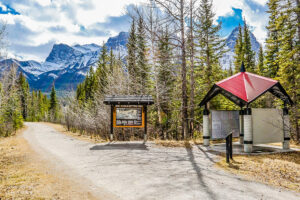
Travel
Trans Canada Trail celebrates 30 years of connecting Canadians
The trail started with a vision to link Canada coast to coast to coast. Now fully connected, it’s charting an ambitious course for the future.
- 1730 words
- 7 minutes
Travel
Seven sites in the birthplace of rock ‘n’ roll commemorate the city’s foundational role in the American civil rights movement

In the spring of 1968, Reverend Martin Luther King travelled to Memphis, Tennessee to support a strike by Black sanitation workers at the height of the American civil rights movement.
In a prophetic address laden with symbolic imagery, King implored the U.S. to live up to its ideals and hinted at the possibility of his own untimely death as the emotional crowd clapped and shouted out praise.
“I’ve seen the Promised Land,” King said on April 3, 1968. “I may not get there with you. But I want you to know that we, as a people, will get to the Promised Land.”
It would turn out to be the final speech of his life.

The Clayborn Temple — the organizing headquarters for the famous strike — is the latest monument to be added to the U.S. Civil Rights Trail, a unique series of exhibitions and landmarks spanning 15 U.S. states that brings to life MLK’s story and Black America’s gut-wrenching struggle for equality.
Journalist and author Clint Smith recently wrote that the U.S. “will never be the country it wants to be until it properly remembers what it did (and does) to Black people.” The Civil Rights Trail, which opened in 2018, represents a good start, with a detailed website including interviews with surviving activists and maps that help visitors plan road trips linking landmarks from Memphis to Little Rock, Ark., Birmingham, Ala. and beyond.
Memphis has seven sites on the heritage trail, including the I AM A MAN plaza, located next to the Clayborn and commemorating the slogan coined by the strikers to protest their poor pay and dangerous working conditions.
After sitting for years in a state of disrepair, the Clayborn, a Romanesque Revival church, is undergoing a $14-million renovation. The roof will be raised, the original stained-glass windows and bell tower restored, and an addition built at the back. It will reopen as a cultural centre that honours the past and creates a space for activism around the ongoing fight for racial justice in the U.S.
“Restoring this great church is important to the city’s identity. It also speaks to the larger story about the struggle for civil rights here in our city,” says Christine Anglin, deputy director of the Historic Clayborn Temple.
Several blocks north of the plaza, close to the Mississippi River, is the most sorrowful of stops: the Lorraine Motel, where King stayed.
Back in the day, the two-story motel was a safe haven for Black travellers, listed in the Green Guide, a compilation of places friendly to African-Americans during the Jim Crow era.
Today it is the site of the National Civil Rights Museum. The building’s façade appears frozen in time: the original motel sign stands above a two-storey block of rooms, their doors still painted turquoise, and a 1966 Lincoln Continental convertible, like King’s, is parked in front.

Inside, you can see room 306, where King stayed. At 6:01 p.m. on April 4, 1968, he stood on the balcony and called down to his friends below, asking musician Ben Branch to play his favourite song, “Take my Hand, Precious Lord,” at a rally planned for later that evening.
As he turned his back, a single gun shot rang out. Struck in the face, King never regained consciousness. News of the leader’s assassination sparked outbreaks of violence across the U.S., resulting in 40 deaths.
“When he died, I think something died in all of us. Something died in America. Each day we must find a way to dream the dream that he dreamed. And build on what he left all of us,” said the late Rep. John Lewis, a civil rights leader and long-time U.S. Congressman.
The museum includes the old rooming house across the street where King’s killer, escaped fugitive James Earl Ray, hid out in a tiny bathroom. The distance between the rooming house and the motel is just 207 feet; King never stood a chance.
You can also see the evidence from the case: Ray’s hunting rifle, a radio with his old prison number on it, the bullet that was removed from King’s body.
Panels on display explore “lingering questions” about the assassination, including whether Ray was working with the U.S. government and if the FBI killed King.
For those who don’t know much about the civil rights movement, the museum is a powerful way to learn about this defining chapter of U.S. history. There are exhibits chronicling five centuries of slavery, emancipation in 1862, the ongoing persecution of African-Americans and the more than 100-year fight for equality. Oral histories and film footage as well as interactive exhibits bring the struggle to life. You can climb on a vintage yellow public bus from Montgomery, Ala., sit near a statue of Rosa Parks, the civil rights pioneer who was jailed in 1955 for not giving up her seat for a white passenger, and get a sense of the terror she must have felt. “Please move to the back of the bus. I need that seat now. Please move back,” a voice barks out. “If you don’t move out of that seat, I’ll have you arrested. Get up from there.”
You can also sit at a segregated lunch counter, visit a courtroom and listen to police sirens wailing as you walk past statues of officers with gas masks ordering people to disperse.
The museum also showcases the non-violent resistance and courage of the Freedom Riders, and the hope and resilience of so many in the community who died fighting for the liberation of others. “Blacks defied oppression with words as weapons, actions and agitation. They kept alive African-American traditions,” notes one exhibit.

As the Memphis portion of the heritage trail continues, the celebration of African-American music comes to life at the Stax Museum of American Soul Music, site of the former Stax Records. It was here that iconic Black musicians such as Otis Redding, Isaac Hayes, Sam & Dave, Aretha Franklin, Ike and Tina Turner launched their careers and helped give birth to American soul music. The studio was founded in 1957 by Jim Stewart and Estelle Axton, siblings who brought together some of the first integrated groups, including house band Booker T. & the M.G.’s. Influenced by Mississippi sharecroppers who sang country, blues and gospel as they picked cotton, Black and white musicians worked together to create masterpieces that play on the radio to this day. This flourishing of creativity at a time when society was so divided illustrates the power of music to bring people together, and showcases Memphis as a cultural crossroads.
This historically Black downtown neighbourhood stretches three kilometres from the Mississippi River to East Street, and was a melting pot of live music, including R&B, gospel, jazz and rock ‘n’ roll.
Today, Beale Street’s neon signs, blues clubs and restaurants are major tourist attractions — festivals and outdoor concerts abound. Past the booming blues stands Beale Street Baptist Church, built in 1869. Once the office of Ida B. Wells’ anti-segregationist newspaper, a life-size statue outside the church commemorates her role as an investigative journalist and co-founder of the National Association for the Advancement of Coloured People.
This boutique hotel, with a rock and blues sensibility, is located on the site of the former Grand Central Station in the historic South Main neighbourhood. The hotel lobby has a wall of amplifiers and a beaded portrait of singer Isaac Hayes. There is an Amtrak station with trains to Chicago next door. Check out the listening room in the lounge, home to a Memphis-inspired vinyl collection.
Are you passionate about Canadian geography?
You can support Canadian Geographic in 3 ways:

Travel
The trail started with a vision to link Canada coast to coast to coast. Now fully connected, it’s charting an ambitious course for the future.

Mapping
As Canada's most famous trail celebrates its near completion, Esri Canada president Alex Miller discusses the ambitious trail map that is helping Canadians get outdoors

People & Culture
The Charter goals and Indigenous people living in Canada

Travel
An ancient Mi’gmaq migration route that follows the Nepisiguit River’s winding route to the salt waters of Chaleur Bay, the Nepisiguit Mi’gmaq Trail is now one of the world’s best adventure trails